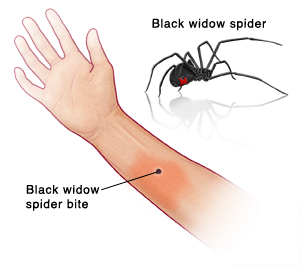Black Widow Spider Bite
Most spiders are harmless to people. But there are 2 types of spiders in the U.S. that can cause harm: the black widow and the brown recluse. People bitten by a black widow or brown recluse spider should get medical care right away.
Black widow spiders are black and shiny. They are about a ½ inch to 1 inch long. Only female black widows are dangerous. They have a red or orange marking on the underside of their belly (abdomen). (The marking is most often an hourglass shape, but this may vary). Black widow spiders are found all over the U.S. But they're most common in the southern and western states. They live outdoors in places such as woodpiles, porch furniture, and fences. They don't often go inside homes. But they can be found in dark corners of garages, basements, and outhouses. They generally don't bite unless they feel threatened.
When the black widow spider bites, it injects a small amount of venom. This can cause pain, numbness, tingling, redness, and swelling at the bite site. Other symptoms include muscle cramps all over the body and severe belly pain. Shaking (tremors), sweating, rapid breathing, weakness, headaches, upset stomach (nausea), and vomiting can also occur. In severe cases, the person may also develop a fast heart rate and high blood pressure. Symptoms most often appear 30 minutes to 2 hours after the bite. They may last for 24 to 72 hours. Symptoms may be worse in children and older adults.
The bite site will be cleaned. Cold packs may be used to slow the soaking up of the venom, and ease pain and swelling. Medicine may be given to ease pain and muscle spasms. A tetanus shot may also be given, if needed. For severe cases, a medicine called antivenin may be given. This carries a small risk of allergic reaction. A delayed reaction to the antivenin can also occur 1 to 2 weeks later. This is called serum sickness. This may cause symptoms, such as rash, fever, and joint pain.

Home care
-
Apply cold packs to the bite site to ease pain and swelling. You can use a cool wet washcloth. Or make a cold pack by putting ice cubes in a plastic bag that seals at the top Then wrap the bag in a thin towel. Don't put ice directly on the skin.
-
To help relieve pain, you may use acetaminophen or ibuprofen. If needed, another pain medicine may be prescribed. If you have chronic liver or kidney disease or ever had a stomach ulcer or digestive tract bleeding, talk with your healthcare provider before using these medicines.
-
Medicines may be prescribed to relieve muscle spasms. Antibiotics may also be prescribed to prevent or treat infection. Make sure to take these medicines as directed. Also be sure to complete the medicines.
-
Watch for any signs of allergic reaction to the antivenin, if it was given (see below). If mild serum sickness occurs, you can treat this at home with medicines such as ibuprofen or naproxen. For more serious symptoms, contact your healthcare provider.
-
Check the bite site daily for signs of infection (see below).
Follow-up care
Follow up with your healthcare provider as advised.
When to call your healthcare provider
Call your healthcare provider right away if any of these occur:
-
Fever of 100.4°F (38.0°C) or above, or as advised by your provider
-
Belly pain
-
Chest tightness or trouble breathing
-
Muscle pain, cramping, and rigidity
-
Upset stomach and vomiting
-
Symptoms last longer than 3 days
-
Signs of allergic reaction to antivenin, such as skin itching, redness, face or mouth swelling, or problems breathing
-
Signs of serum sickness (such as moderate to severe rash, fever, or joint pain starting 1 to 2 weeks after treatment)
-
Signs of infection at the bite site (such as increased redness or streaking, swelling, pain, or bad-smelling fluid leaking)
-
Bleeding from the bite site that does not stop after 5 minutes of firm pressure
-
Bite site becomes black or blue
-
Bite site won’t heal or becomes larger
-
An open sore (skin ulcer) forms at the bite site